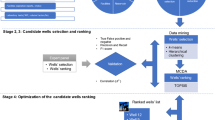Abstract
Stepwise linear discriminant analysis and regression function techniques were used to classify and analyze the data from 224 oil, gas, and dry holes drilled to the base of the Silurian Geologic System in southeast Ohio, U.S.A., from 1968 to 1975. These are 8.7% of all wells drilled in the same geographical area over the time interval. The wells were divided into six groups depending on the amount of control the drilling company had over their ultimate completion. Thirteen environmental (geologic and engineering) factors plus location data were collected about each well. Successive groupings of oil and gas wells were used to determine an environmental index which was used to establish the hydrocarbon producing potential of the next group. Discriminant analysis was used to determine whether the wells within each group were classified properly and regression analysis was used to determine a production estimating function. Geophysical well data were used to estimate whether gas or oil was expected. With this dichotomy, production estimating functions which explain 74% of the variation for oil wells and 78% of the variation for gas wells were formulated. Using the discriminant function for these groups as a ranking function the following results were obtained: For oil wells, 18.5% Type II errors for the productive group and 24.4% Type II errors for the nonproductive group; for gas wells, 5.4% Type II errors for the productive group and 17.1% Type II errors for the nonproductive group. By accepting the above Type II errors one is significantly able to reduce the number of noneconomic wells completed that originally should have been considered dry holes. The inverse was tested with three wells and yielded 33% Type II errors. Any area in which adequate data are available is amenable to these types of analysis with their attendant diagnostic capabilities.
Similar content being viewed by others
References
Calvetty, N., 1979, Curve decline analysis performed with electronic computers applied to normalized production of gas and oil from Clinton Sand SE Ohio, Tulane University, Graduate School of Engineering, New Orleans, La. (Research project directed by author.)
Chadwick, G. H., 1918, Stratigraphy of New York Clinton: Geol. Soc. Amer. Bull., v. 29, p. 327–368.
Chayes, F. and Velde, D., 1965, On distinguishing basaltic lavas of circum-oceanic and ocean-island type by discriminant functions: Jour. Sci., v. 263, p. 206–222.
Cozzolino, J. M., 1972, Sequential search for an unknown number of objects of nonuniform size: Oper. Res., v. 20, no. 2, p. 293–308.
Dixon, W. J., 1971, BMD biomedical computer programs: Univ. of Calif. Press, Berkeley and Los Angeles, p. 214a-214t, 233–257d.
Doveton, J. H., 1976, Linear discriminant analysis can be used as an oil-prospect exploration guide: Oil Gas Jour., v. 74, n. 17, p. 324–328.
Fettke, C. R., 1950, Summarized record of deep wells in Pennsylvania: Pa. Geol. Surv. Bull., M 31.
George, J. V., 1979, The evolution of fracturing—one companies history, meeting: Ohio Oil and Gas Association.
Gurley, J., 1963, A productivity and economic projection method—Ohio Clinton Sand gas wells, Jou. Petrol. Tech., v. 15, p. 1183–1188.
Harbaugh, J. W., Doveton, J. H. and Davis, J. C., 1977, Probability methods in oil exploration: Wiley, New York, p. 167–191.
Krumbein, W. C. and Graybill, F. A., 1965, An introduction to statistical models in geology: McGraw-Hill, New York, p. 359–367.
Lipson, L. B., 1973, A new look in exploration and development of oil producing provinces: Tenth Annual Meeting, Society of Independent Professional Earth Scientists, New Orleans, La. Abstract, 1 p.
Locke, C. D., Schrider, L. A., and Romeo, M. K., 1968, A unique approach to oil-production curve analysis with applications: 43rd Annual Meeting, Society of Petroleum Engineers of AIME, Houston, Texas. SPE Paper No. 2224.
Loper, R. G., 1963, General report of the study committee Meeting: Independent Oil and Gas Association, Charleston, West Virginia.
Loper, R. G., 1970, Personal communication.
McWilliams, P. C. and Tesarik, D. R., 1978, Multivariate analysis techniques with applications in mining: U.S. Bureau of Mines Information Circular 8782, p. 10–11, 37–40.
Mellon, G. B., 1964, Discriminatory analysis of calcite and silicate-cemented phases of the mountain park sandstone: Jour. Geol., v. 72, p. 786–809.
Morrison, D. G., 1969, On the interpretation of discriminant analysis, Jour. Market. Res., vol. VI, no. 5, p. 156–163.
Nie, N. H., Hull, C. H., Jenkins, J. G., Steinbrenner, K., and Bent, D. H., 1975, Statistical package for the social sciences: McGraw-Hill, N.Y., p. 320–367, 434–467.
Pasini, J., III, and Overby, W. K., Jr., 1969, Natural and induced systems and their applications to petroleum production: 44th Annual Meeting, Society of Petroleum Engineers of AIME, Denver, Colorado, SPE Paper No. 2565.
Schrider, L. A., 1976, Personal communication.
Schrider, L. A. and Byrd, J., 1971, Discriminant analysis as a technique for exploitation of petroleum reservoirs: 46th Annual Meeting, Society of Petroleum Engineers of AIME, New Orleans, La., SPE Paper No. 3567.
Watts, R. J., Schrider, L. A., and Draig, J. G., 1971, 1972, Reservoir and production characteristics of the Clinton Sand, East Canton oil field: Winter Meeting, Ohio Oil and Gas Association, Columbus, Ohio. Previously presented, Eastern Regional Meeting, Society of Petroleum Engineers of AIME, Charleston, W. Va., SPE Paper No. 3661.
Weaver, O. D., Calvert, W. L., and McGuire, W. H., January 17, 1972, A new look at the oil and gas potential of the Appalachin Basin: Oil Gas Jour., v. 70, no. 3, p. 126, 128–130.
Wignall, T. K., 1968, Oil and gas exploration, statistical decision criteria: Applications of discriminant analysis in the petroleum industry: 43rd Annual Meeting, Society of Petroleum Engineers of AIME, Houston, Texas. SPE Paper No. 2223.
Wood, G. V., 1961, Discriminating between refractory and non-refractory quartzite by quantitative petrography, Jour. Sediment. Petrol., v. 31, p. 530–533.
Author information
Authors and Affiliations
Rights and permissions
About this article
Cite this article
Lipson, L.B. A new look in exploration and development of old producing properties. Mathematical Geology 12, 377–398 (1980). https://doi.org/10.1007/BF01029422
Received:
Issue Date:
DOI: https://doi.org/10.1007/BF01029422




